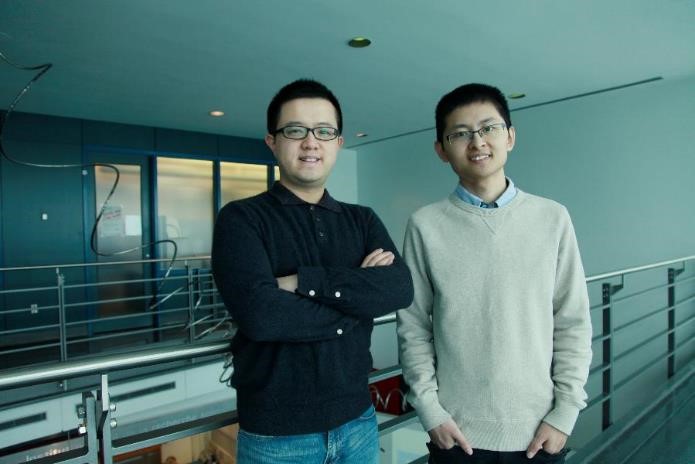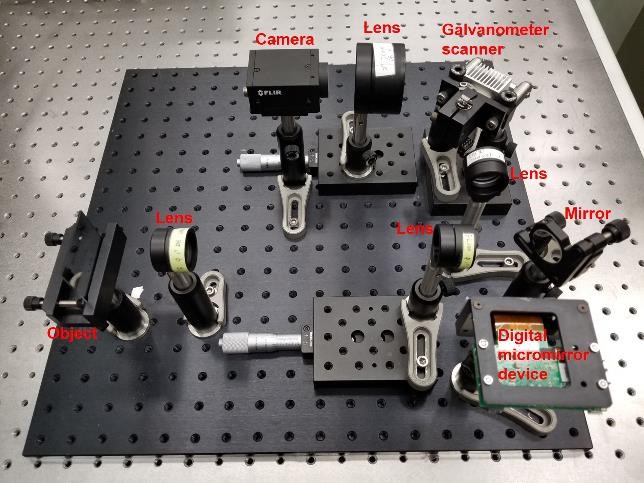March 7, 2019
by Optical Society
Researchers have developed a new imaging method that can capture images at speeds of up to 1.5 million frames per second using standard imaging sensors typically limited to 100 frames per second. This new technology will make it possible to capture extremely fast events for applications such as biomedical research or slow-motion scenes in a film.
Researchers from the Institut National de la Recherche Scientifique (INRS) in Canada describe their new method, called compressed optical-streaking ultra-high-speed photography (COSUP), in The Optical Society (OSA) journal Optics Letters. They show the power of COSUP by using it to capture the transmission of a single laser pulse with a width of just 10 microseconds.
“COSUP has a wide range of potential applications because it can be integrated into many imaging instruments from microscopes to telescopes,” explained Jinyang Liang, an assistant professor at INRS and the corresponding author for the paper. “Using different CCD and CMOS cameras with COSUP also allows the method to be used for a wide range of wavelengths and for acquiring various optical characteristics such as polarization.”
The researchers say that the COSUP system might also be useful to the movie industry and sports videography, where high-speed cameras are used to capture detailed, quick movements for playback in slow motion. They are also working to miniaturize the system to allow high-quality slow-motion video capture with a smartphone.
Faster imaging
Although today’s cameras are very sensitive and can be used with a wide range of wavelengths, their speed is typically limited because of the imaging sensor. Specialty high-speed cameras come with limiting trade-offs such as recording only a few frames at high speeds, one-dimensional imaging, low resolution, or a bulky and expensive setup. The researchers developed COSUP to work around these challenges by combining a computational approach called compressed sensing with an imaging method called optical streak imaging.
“COSUP has specifications similar to existing high-speed cameras with an imaging speed that is tunable from tens of thousands of frames per second to 1.5 million frames per second,” said Liang. “We used off-the-shelf components to create a very economical system.”
To perform COSUP, compressed sensing is used to spatially encode each temporal frame of a scene using a digital micromirror device, or DMD. This process labels the capture time of each frame much like a unique barcode. Then a scanner is used to perform temporal shearing, creating an optical streak image — a linear image from which the temporal properties of light can be inferred — that is captured with a traditional camera in a single shot.
“Even though the streak image contains a mixture of 2D space and time information, we can separate the data using reconstruction because of the unique labels attached to each temporal frame,” said Xianglei Liu, a doctoral student at INRS and the lead author of the paper. “This gives COSUP a 2D imaging field of view that can record hundreds of frames in each movie at 1.5 million frames per second and a resolution of 500 × 1000 pixels.”

Jinyang Liang left and Xianglei Liu were part of the research team who developed the COSUP system, which can achieve imaging speeds up to 1.5 million frames per second with a traditional camera. Image Credit: Jinyang Liang, Institut National de la Recherche Scientifique
Capturing a single laser pulse
The researchers demonstrated COSUP by imaging two short-lived events with a CMOS camera. In the first experiment, they fired four laser pulses, each with a pulse width of 300 microseconds, through a mask with the letters USAF. Using COSUP with an imaging speed of 60,000 frames per second they were able to record this event with 240 frames. By increasing the imaging speed to 1.5 million frames per second, they recorded a single 10-microsecond laser pulse transmitting through the USAF mask.
In the second experiment, the researchers traced the position of a fast-moving ball pattern. Using COSUP at an imaging speed of 140,000 frames per second, they recorded the spatial position and the shape of the ball pattern over time. They also measured the centroid of the ball in each temporal frame and compared it with the known location, which showed that COSUP could accurately trace the ball’s position.
The researchers plan to use a COSUP system to measure the phosphorescence lifetimes of individual nanoparticles, which could be used to create an optical nanothermometer that would aid a light-based medical treatment known as photodynamic therapy.
They are also working on using COSUP to improve the imaging of membrane voltage of neurons, which can help reveal the cellular mechanisms underlying brain functions. This type of imaging is challenging because the process is transient and nonrepeatable and the indicators used produce little light. “Using COSUP with highly sensitive cameras such as an electron-multiplying CCD would enable the real-time, fast imaging required for this application,” said Liang.
The researchers are also working to make the bench-top system compact enough to use outside and eventually for incorporation into smartphones. They have initiated an industrial collaboration with Axis Photonique to further develop COSUP toward a commercial product.
Paper: X. Liu, J. Liu, C. Jiang, F. Vetrone, J. Liang, “Single-shot Compressed Optical-Streaking Ultra-highspeed Photography,” Opt. Lett., Vol. 44, pp, 1387-1390 (2019).
DOI:10.1364/OL.44.001387.















